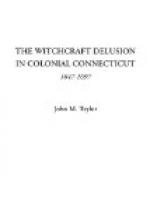“Meanwhile notaries, copyists, and innkeepers grew rich. The executioner rode a blooded horse, like a noble of the court, and went clad in gold and silver; his wife vied with noble dames in the richness of her array. The children of those convicted and punished were sent into exile; their goods were confiscated; plowman and vintner failed.” (The Witch Persecutions, pp. 13-14, BURR.)
Fanaticism did not rule and ruin without hindrance and remonstrance. Men of great learning and exalted position struck mighty blows at the root of the evil. They could not turn the tide but they stemmed it, and their attacks upon the whole theory of Satanic power and the methods of persecution were potent in the reaction to humanity and a reign of reason.
Always to be remembered among these men of power are Johann Wier, Friedrich Spee, and notably Reginald Scot, who in his Discovery of Witchcraft, in 1584, undertook to prove that “the contracts and compacts of witches with devils and all infernal spirits and familiars, are but erroneous novelties and erroneous conceptions.”
“After all it is setting a high value on our conjectures to roast a man alive on account of them.” (MONTAIGNE.)
Who may measure in romance and the drama the presence, the cogent and undeniable power of those same abiding elements of mysticism and mystery, which underlie all human experience, and repeated in myriad forms find their classic expression in the queries of the “Weird Sisters,” “those elemental avengers without sex or kin”?
“When shall we three meet again,
In thunder, lightning or in rain?
When the hurly burly’s done,
When the battle’s lost and won.”
Are not the mummeries of the witches about the cauldron in Macbeth, and Talbot’s threat pour la Pucelle,
“Blood will I draw on thee, thou art a witch,”
uttered so long ago, echoed in the wailing cry of La Meffraye in the forests of Machecoul, in the maledictions of Grio, and of the Saga of the Burning Fields?
Their vitality is also clearly shown in their constant use and exemplification by the romance and novel writers who appeal with certainty and success to the popular taste in the tales of spectral terrors. Witness: Farjeon’s The Turn of the Screw; Bierce’s The Damned Thing; Bulwer’s A Strange Story; Cranford’s Witch of Prague; Howells’ The Shadow of a Dream; Winthrop’s Cecil Dreeme; Grusot’s Night Side of Nature; Crockett’s Black Douglas; and The Red Axe, Francis’ Lychgate Hall; Caine’s The Shadow of a Crime; and countless other stories, traditions, tales, and legends, written and unwritten, that invite and receive a gracious hospitality on every hand.
CHAPTER III
“A belief in witchcraft had always existed; it was entertained by Coke, Bacon, Hale and even Blackstone. It was a misdemeanor at English common law and made a felony without benefit of clergy by 33 Henry VIII, c. 8, and 5 Eliz., c. 16, and the more severe statute of I Jas. 1, ch. 12.” Connecticut—Origin of her Courts and Laws (N.E. States, Vol I, p. 487-488), HAMERSLEY.




